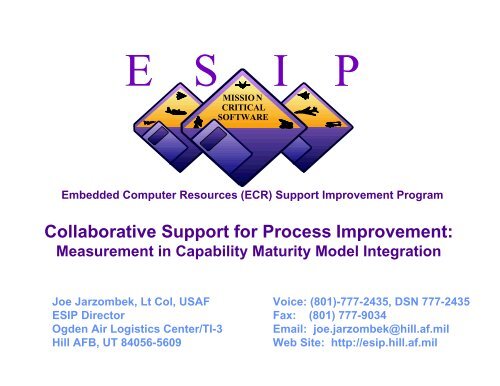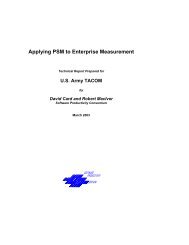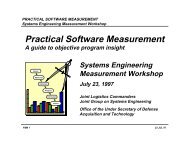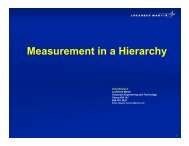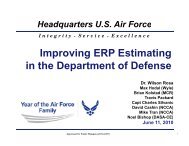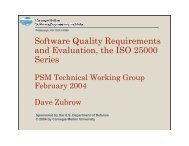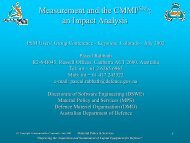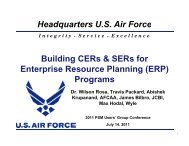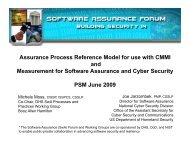Measurement in the Capability Maturity Model Integration (CMMI)
Measurement in the Capability Maturity Model Integration (CMMI)
Measurement in the Capability Maturity Model Integration (CMMI)
Create successful ePaper yourself
Turn your PDF publications into a flip-book with our unique Google optimized e-Paper software.
E S I P<br />
MISSION<br />
CRITICAL<br />
SOFTWARE<br />
Embedded Computer Resources (ECR) Support Improvement Program<br />
Collaborative Support for Process Improvement:<br />
<strong>Measurement</strong> <strong>in</strong> <strong>Capability</strong> <strong>Maturity</strong> <strong>Model</strong> <strong>Integration</strong><br />
Joe Jarzombek, Lt Col, USAF<br />
ESIP Director<br />
Ogden Air Logistics Center/TI-3<br />
Hill AFB, UT 84056-5609<br />
Voice: (801)-777-2435, DSN 777-2435<br />
Fax: (801) 777-9034<br />
Email: joe.jarzombek@hill.af.mil<br />
Web Site: http://esip.hill.af.mil
<strong>Measurement</strong> <strong>in</strong> <strong>CMMI</strong><br />
Why Have a PSM Users’ Group Conference?<br />
Facilitates Communications<br />
• Shar<strong>in</strong>g Solutions<br />
• Shar<strong>in</strong>g Lessons Learned<br />
• Network<strong>in</strong>g with Professionals<br />
• Explor<strong>in</strong>g New Technologies<br />
facilities of<br />
exploration<br />
Facilities of<br />
belong<strong>in</strong>g<br />
facilities of<br />
alignment<br />
Directly Serves Multi-discipl<strong>in</strong>e<br />
Needs of <strong>the</strong> DoD support<br />
community (govn & <strong>in</strong>dustry)<br />
facilities of<br />
engagement<br />
<strong>Measurement</strong> Mafia<br />
When we do someth<strong>in</strong>g toge<strong>the</strong>r over time,<br />
we create shared practices:<br />
we learn to do what needs do<strong>in</strong>g;<br />
we learn about each o<strong>the</strong>r, and<br />
we developed shared ways of<br />
do<strong>in</strong>g th<strong>in</strong>gs<br />
We form communities of practice.<br />
Pg. 2
<strong>Measurement</strong> <strong>in</strong> <strong>CMMI</strong><br />
National Security System Challenges<br />
Mission Critical Software <strong>in</strong> National Security Systems<br />
Information<br />
Technology is<br />
vital to mission<br />
effectiveness for<br />
operations<br />
<strong>in</strong>volv<strong>in</strong>g<br />
national security<br />
systems<br />
Software<br />
provides<br />
<strong>in</strong>creased<br />
system<br />
capability &<br />
flexibility<br />
Pg. 3
<strong>Measurement</strong> <strong>in</strong> <strong>CMMI</strong><br />
National Security Systems Challenges<br />
• The quantity of software <strong>in</strong><br />
national security systems is<br />
<strong>in</strong>creas<strong>in</strong>g dramatically<br />
• Increases <strong>in</strong> program<br />
schedules & cost (both <strong>in</strong><br />
acquisition & susta<strong>in</strong>ment)<br />
prompt need for software<br />
solutions <strong>in</strong> Information<br />
Technology (IT) <strong>in</strong> National<br />
Security Systems (NSS =<br />
MCCR)<br />
Billions of Dollars<br />
DoD Computer Hardware & Software Costs<br />
45<br />
40<br />
35<br />
30<br />
25<br />
20<br />
15<br />
10<br />
5<br />
0<br />
23.1<br />
20.4<br />
16.5<br />
11.4 13.6<br />
25.6 27.3 29.1 31 33 35.7<br />
Software<br />
2.9 3.4 3.9 4.5 5.1 5.6 5.9 6.1 6.3 6.5 6.8<br />
Hardware<br />
84 85 86 87 89 90 91 92 93 94 95<br />
Year<br />
Pg. 4
<strong>Measurement</strong> <strong>in</strong> <strong>CMMI</strong><br />
The Software Challenge & Potential<br />
The Challenge<br />
Poor Success Rate<br />
• 1% projects on time, on budget, and meet expectations<br />
• 33% never f<strong>in</strong>ish<br />
Unacceptable Schedule Variance<br />
• Average is one year beh<strong>in</strong>d schedule<br />
• Average schedule missed by 50%<br />
75% are “Operational Failures”<br />
The Potential<br />
1% improvement saves $300M+<br />
CMM-based improvement shows a 4<br />
- 19% potential ga<strong>in</strong> *<br />
Sources: The Healthy Software Project,<br />
Mark Norris, Wiley: 1995<br />
* Depends on amount of reuse<br />
Guidel<strong>in</strong>es for Successful Acquisition and Management of<br />
Software-Intensive Systems, Version 2.0, STSC,1996<br />
* CMM Level 5 f<strong>in</strong>d<strong>in</strong>gs as reported<br />
<strong>in</strong> May 99 CrossTalk<br />
Pg. 5
<strong>Measurement</strong> <strong>in</strong> <strong>CMMI</strong><br />
US Government Acquisition Role:<br />
Evolv<strong>in</strong>g from Oversight to Insight<br />
Where we’ve been:<br />
Observe<br />
Where we’re go<strong>in</strong>g:<br />
Observe<br />
Manage<br />
Reduction of<br />
Government<br />
Resources<br />
Track<br />
Manage<br />
Risk Avoidance<br />
i System Specification<br />
i Mil Spec/Standards<br />
i Government <strong>in</strong> design<br />
i Government Basel<strong>in</strong>e<br />
i Design-to-Cost/Life Cycle Cost<br />
i Program Control<br />
i CDRLs (Contract Deliverables)<br />
i SOW (Statement of Work)<br />
Risk Management<br />
i Performance Based Contract<strong>in</strong>g<br />
i Best Practices not Mil-Specs<br />
i Bilateral Technical System Basel<strong>in</strong>e<br />
i Cost as an Independent Variable<br />
(CAIV) and Cost-Risk<br />
i IPTs and IMP/IMS/EVMS Control<br />
i Metrics and TPMs<br />
i Data availability - m<strong>in</strong>imize CDRLs<br />
i SOO (Statement of Obj) -- CSOW<br />
Pg. 6
<strong>Measurement</strong> <strong>in</strong> <strong>CMMI</strong><br />
Cop<strong>in</strong>g with Bus<strong>in</strong>ess Challenges & Need for<br />
Performance Improvement<br />
Where we’ve been:<br />
Observe<br />
Where we’re go<strong>in</strong>g:<br />
Observe<br />
Manage<br />
Reduction of<br />
Government<br />
Resources<br />
Track<br />
Manage<br />
Risk Avoidance<br />
Risk Management<br />
How do I<br />
measure, monitor and<br />
manage<br />
program risks?<br />
Which technologies<br />
should I adopt now<br />
or track for future<br />
<strong>in</strong>vestment?<br />
How do I recruit and<br />
reta<strong>in</strong> technical expertise<br />
on my staff?<br />
How effective is<br />
my organization <strong>in</strong> meet<strong>in</strong>g<br />
bus<strong>in</strong>ess & mission<br />
objectives?<br />
How do I prioritize<br />
and fund compet<strong>in</strong>g<br />
projects and<br />
improvements?<br />
How do I rema<strong>in</strong><br />
cognizant of changes to<br />
laws, directives & policies?<br />
What’s <strong>the</strong> impact of<br />
comply<strong>in</strong>g with <strong>the</strong>m?<br />
Pg. 7
<strong>Measurement</strong> <strong>in</strong> <strong>CMMI</strong><br />
Steps to Enterprise-wide Organizational <strong>Maturity</strong>:<br />
1. Vision, Goals, Buy-<strong>in</strong><br />
Org name<br />
Section name Section name Section name Section name<br />
2. Process<br />
Capture<br />
RCP<br />
PROCESS RCP Validated<br />
PHASE 1 RCP<br />
1<br />
PLAN, COORDINATE<br />
AND APPROVE A<br />
MAINTENANCE<br />
SOFTWARE PROJECT<br />
PACKAGE<br />
PHASE 2<br />
2<br />
CCB VCN<br />
approval<br />
Rejected<br />
contractor cost<br />
proposal<br />
Contractor<br />
Reports<br />
Organization<br />
Processes<br />
MWSSS OI 21-7<br />
F<strong>in</strong>al CCB package<br />
PUT THE<br />
MAINTENANCE Awarded<br />
SOFTWARE PROJECT Contract<br />
ON CONTRACT<br />
PHASE 3<br />
MANAGE THE<br />
3<br />
EXECUTION OF<br />
Operational acceptance message<br />
THE MAINTENANCE<br />
SOFTWARE PROJECT<br />
CAT2 Deficiencies<br />
PHASE 4<br />
4<br />
3. Gap Analysis<br />
Validated<br />
RCP<br />
Delayed<br />
CCB<br />
package<br />
Rejected<br />
contractor<br />
cost<br />
proposal<br />
OASB m<strong>in</strong>utes OARB m<strong>in</strong>utes<br />
21ST SW<br />
21-10401<br />
PERFORM VCN<br />
ANALYSIS<br />
Release Factors<br />
2.1.1<br />
CONSULT WITH Informal assessment<br />
SOFTWARE IPT of Release Factors<br />
2.1.2<br />
PREPARE<br />
CCB<br />
PACKAGE<br />
2.1.3<br />
CCB package template<br />
Best<br />
Practices<br />
CCB package<br />
CLOSEOUT THE<br />
MAINTENANCE<br />
SOFTWARE PROJECT<br />
PHASE 5<br />
5<br />
PREPARE ACQUISITION<br />
STRATEGY BRIEFING<br />
2.1.4<br />
Personnel<br />
Distributed<br />
signed<br />
project<br />
closeout<br />
report<br />
Acquisition<br />
strategy brief<strong>in</strong>g<br />
CONDUCT<br />
ACQUISITION<br />
STRATEGY<br />
2.1.5<br />
NODE: TITLE: NUMBER:<br />
MAINTAIN AIR FORCE SPACE COMMAND<br />
0<br />
SENSOR SOFTWARE<br />
Sensor IPT<br />
Mystic Algorithms<br />
Validated RCP PREPARE AND Draft VCN<br />
COORDINATE<br />
DRAFT VCN<br />
Approved<br />
2.1.6<br />
acquisition<br />
strategy<br />
NODE: TITLE: NUMBER:<br />
PLAN PROJECT<br />
2.1<br />
4. Process<br />
Transformation<br />
Draft of VCN<br />
staff summary<br />
sheet<br />
CCB<br />
package<br />
GET DRAFT VCN<br />
APPROVAL<br />
Personnel<br />
2.3.1<br />
Configuration<br />
Management<br />
REVIEW<br />
CCB PACKAGE<br />
2.3.2<br />
Proposed<br />
CCB agenda<br />
DRY-RUN<br />
CCB<br />
2.3.3<br />
SSM<br />
Approved<br />
CCB<br />
package<br />
Delayed CCB package<br />
Draft VCN approval<br />
Conditionally<br />
approved CCB<br />
package<br />
MODIFY<br />
CCB<br />
SLIDES<br />
2.3.4<br />
Configuration Management<br />
REVIEW<br />
CCB<br />
PACKAGE<br />
2.3.5<br />
Customer<br />
F<strong>in</strong>al CCB<br />
agenda<br />
REVIEW VCN<br />
BY CCB<br />
NODE: TITLE: NUMBER:<br />
APPROVE VCN<br />
2.3<br />
2.3.6<br />
PM<br />
Delayed CCB<br />
package<br />
F<strong>in</strong>al CCB package<br />
Disapproved<br />
CCB<br />
package<br />
CCB VCN<br />
approval<br />
CCB<br />
m<strong>in</strong>utes<br />
From Process,<br />
all good th<strong>in</strong>gs flow!<br />
Project Project<br />
Management<br />
Management<br />
Process<br />
Process<br />
Level<br />
Level<br />
Evolution<br />
Evolution<br />
Metrics Metrics<br />
Capture Capture<br />
Activity Activity<br />
Based Based<br />
Cost<strong>in</strong>g Cost<strong>in</strong>g<br />
Simulation Simulation<br />
Pg. 8
<strong>Measurement</strong> <strong>in</strong> <strong>CMMI</strong><br />
Process Improvement Bus<strong>in</strong>ess Case<br />
Software Process Improvement (SPI)<br />
Demonstrated Return on Investment (ROI)<br />
SPI efforts quantifiably justify fund<strong>in</strong>g (based on several projects)<br />
• Demonstrated Return on Investment of 4:1 - 19:1<br />
• Earlier detection of software defects from 22% - 90%<br />
• Reduction <strong>in</strong> post-release defects from 39% - 84%<br />
• Reduction <strong>in</strong> schedule time from 19% - 23%<br />
• Reduction <strong>in</strong> projected schedule variance down to 2%<br />
• Increased productivity (less rework) of 35% - 75%<br />
• Reduced susta<strong>in</strong>ment costs by 30% - 55%<br />
Several programs have improved <strong>the</strong>ir capabilities based on <strong>the</strong><br />
Software <strong>Capability</strong> <strong>Maturity</strong> <strong>Model</strong> (CMM)<br />
• Enabled effective communication between separate bus<strong>in</strong>ess units;<br />
• Report<strong>in</strong>g improved customer satisfaction<br />
Pg. 9
The Current Situation<br />
<strong>Measurement</strong> <strong>in</strong> <strong>CMMI</strong><br />
Explosion of CMMs<br />
and CMM-like models<br />
Multiple models with<strong>in</strong><br />
an organization<br />
Multiple assessments<br />
Multiple tra<strong>in</strong><strong>in</strong>g<br />
Duplicated expenses<br />
Pg. 10
PSP<br />
People<br />
CMM<br />
SA-CMM<br />
SE-CMM<br />
SW-CMM<br />
<strong>Measurement</strong> <strong>in</strong> <strong>CMMI</strong><br />
The Frameworks Quagmire<br />
<strong>CMMI</strong>*<br />
ISO<br />
15504*<br />
(SPICE)<br />
SDCCR<br />
SCE<br />
IPD-<br />
CMM*<br />
SECM*<br />
(EIA/IS 731)<br />
IEEE Stds. 730,828<br />
829, 830,1012,1016<br />
1028,1058,1063<br />
DOD<br />
IPPD<br />
SDCE<br />
Trillium<br />
EQA<br />
Baldrige<br />
FAAiCMM<br />
DO-<br />
178B<br />
MIL-Q<br />
-9858<br />
NATO<br />
AQAP1,4,9<br />
BS<br />
5750<br />
DOD-<br />
STD-<br />
2168<br />
MIL-STD-<br />
498<br />
ISO/IEC<br />
12207<br />
MIL-STD-1679<br />
DOD-STD<br />
-2167A<br />
DOD-STD<br />
-7935A<br />
EIA/IEEE<br />
J-STD-016<br />
SSE-<br />
CMM<br />
MIL-STD<br />
-499B*<br />
IEEE<br />
1220<br />
SECAM<br />
EIA/IS<br />
632<br />
AF IPD<br />
Guide<br />
EIA 632*<br />
TickIT<br />
Q9000<br />
ISO 10011<br />
ISO 9000<br />
Series<br />
ISO 15288*<br />
IEEE<br />
1074<br />
IEEE/EIA<br />
12207<br />
* Not yet released<br />
quag14d: 5 June 1998<br />
Also see www.software.org/quagmire Courtesy Sarah Sheard, SPC<br />
Documented <strong>in</strong> CrossTalk, <strong>the</strong> Journal of Defense Software Eng<strong>in</strong>eer<strong>in</strong>g<br />
Pg. 11
<strong>Measurement</strong> <strong>in</strong> <strong>CMMI</strong><br />
Why is this a problem?<br />
Similar process improvement concepts, but...<br />
Different model representations (e.g. staged,<br />
cont<strong>in</strong>uous, questionnaire, hybrid)<br />
Different term<strong>in</strong>ology<br />
Different content<br />
Different appraisal methods<br />
Different conclusions<br />
Pg. 12
<strong>Measurement</strong> <strong>in</strong> <strong>CMMI</strong><br />
Common Basis for <strong>Model</strong>-based Process Improvement<br />
Improvement <strong>in</strong> any discipl<strong>in</strong>e is a function of perform<strong>in</strong>g:<br />
implement<strong>in</strong>g practices that reflect <strong>the</strong> fundamentals of a<br />
particular topic (e.g. configuration management)<br />
<strong>in</strong>stitutionaliz<strong>in</strong>g practices that lead to susta<strong>in</strong>ment and<br />
improvement of an implementation<br />
Pg. 13
<strong>Measurement</strong> <strong>in</strong> <strong>CMMI</strong><br />
Thus all <strong>CMMI</strong> source models conta<strong>in</strong>:<br />
Implement<strong>in</strong>g practices grouped by aff<strong>in</strong>ity<br />
Institutionaliz<strong>in</strong>g practices that vary from model to<br />
model, however all models specify levels that<br />
describe <strong>in</strong>creas<strong>in</strong>g capability to perform<br />
Pg. 14
<strong>Measurement</strong> <strong>in</strong> <strong>CMMI</strong><br />
Cont<strong>in</strong>uously<br />
improv<strong>in</strong>g<br />
Optimiz<strong>in</strong>g (5)<br />
...<br />
Improvement<br />
Levels<br />
Predictable<br />
process<br />
process<br />
Quantitatively<br />
Managed<br />
(4)<br />
(measured)<br />
Standard,<br />
consistent<br />
process<br />
Def<strong>in</strong>ed (3)<br />
(standard)<br />
Discipl<strong>in</strong>ed<br />
process<br />
Managed (2)<br />
(planned and tracked)<br />
Initial (1)<br />
(performed)<br />
Not performed (0)<br />
Pg. 15
<strong>CMMI</strong> Design Goals<br />
<strong>Measurement</strong> <strong>in</strong> <strong>CMMI</strong><br />
Elim<strong>in</strong>ate <strong>in</strong>consistencies<br />
Reduce duplication<br />
Reduce <strong>the</strong> cost of implement<strong>in</strong>g model-based<br />
process improvement<br />
Increase clarity and understand<strong>in</strong>g<br />
• Common term<strong>in</strong>ology<br />
• Consistent style<br />
• Uniform construction rules<br />
• Common components<br />
M<strong>in</strong>imal impact on legacy efforts<br />
Pg. 16
<strong>Measurement</strong> <strong>in</strong> <strong>CMMI</strong><br />
Benefits<br />
Efficient, effective assessment and improvement across<br />
multiple process discipl<strong>in</strong>es <strong>in</strong> an organization<br />
Reduced tra<strong>in</strong><strong>in</strong>g and assessment costs<br />
A common, <strong>in</strong>tegrated vision of improvement for all elements<br />
of an organization<br />
A means of represent<strong>in</strong>g new discipl<strong>in</strong>e-specific <strong>in</strong>formation<br />
<strong>in</strong> a standard, proven process improvement context<br />
Pg. 17
<strong>Measurement</strong> <strong>in</strong> <strong>CMMI</strong><br />
The Challenge<br />
Given <strong>the</strong> <strong>in</strong>put models, extract <strong>the</strong><br />
common and/or best features<br />
Provide users <strong>the</strong> ability to produce<br />
s<strong>in</strong>gle or multiple discipl<strong>in</strong>e models,<br />
both cont<strong>in</strong>uous and staged, tailored<br />
to <strong>the</strong>ir organizations needs.<br />
Provide users <strong>the</strong> ability to assess<br />
and tra<strong>in</strong> based on <strong>the</strong>se output<br />
models.<br />
Pg. 18
<strong>Measurement</strong> <strong>in</strong> <strong>CMMI</strong><br />
<strong>CMMI</strong> Source <strong>Model</strong>s<br />
<strong>Capability</strong> <strong>Maturity</strong> <strong>Model</strong> for Software V2, draft<br />
C (SW-CMM V2C)<br />
EIA Interim Standard 731, System Eng<strong>in</strong>eer<strong>in</strong>g<br />
<strong>Capability</strong> <strong>Model</strong> (SECM)<br />
Integrated Product Development <strong>Capability</strong><br />
<strong>Maturity</strong> <strong>Model</strong>, draft V0.98 (IPD-CMM)<br />
Pg. 19
Source <strong>Model</strong>s<br />
<strong>Measurement</strong> <strong>in</strong> <strong>CMMI</strong><br />
SW-CMM<br />
V2C<br />
EIA IS 731<br />
SECM<br />
IPD-CMM<br />
V0.98<br />
Staged Cont<strong>in</strong>uous Hybrid<br />
<strong>Maturity</strong> Levels <strong>Capability</strong> Levels<br />
Categories<br />
<strong>Maturity</strong> and<br />
<strong>Capability</strong> Levels<br />
Key Process Areas Focus Areas Process Areas<br />
Key Process Area<br />
Goals<br />
Themes<br />
<strong>Capability</strong> and<br />
Process Area Goals<br />
Activities Common Specific Practices Base Practices<br />
Feature<br />
Common Features Generic Practices Generic Practices<br />
Generic Attributes<br />
Pg. 20
<strong>Measurement</strong> <strong>in</strong> <strong>CMMI</strong><br />
Example Map of Input Process Areas To Source <strong>Model</strong>s<br />
<strong>CMMI</strong> PA<br />
Requirements<br />
Management<br />
Supplier<br />
Agreement<br />
Management<br />
Configuration<br />
Management<br />
Data<br />
Management<br />
SW-CMM<br />
V2C<br />
X<br />
EIA SECM<br />
V1.0<br />
X<br />
IPD-CMM<br />
V0.98<br />
X X X<br />
X X X<br />
Tra<strong>in</strong><strong>in</strong>g X X X<br />
X<br />
Pg. 21
<strong>Measurement</strong> <strong>in</strong> <strong>CMMI</strong><br />
Staged Representations<br />
Key Process Areas are grouped <strong>in</strong> <strong>the</strong> stages (levels)<br />
from 2 to 5<br />
A Key Process Area conta<strong>in</strong>s specific practices<br />
(activities) to achieve <strong>the</strong> purpose of <strong>the</strong> process area.<br />
For a Key Process Area at a given stage,<br />
<strong>in</strong>stitutionalization practices are <strong>in</strong>tegral to <strong>the</strong> process<br />
area.<br />
Pg. 22
Staged <strong>Model</strong><br />
<strong>Measurement</strong> <strong>in</strong> <strong>CMMI</strong><br />
Level Focus Key Process Areas<br />
5<br />
Optimiz<strong>in</strong>g<br />
4<br />
Quantitatively<br />
Managed<br />
3<br />
Def<strong>in</strong>ed<br />
Cont<strong>in</strong>uous<br />
process<br />
improvement<br />
Quantitative<br />
management<br />
Process<br />
Standardization<br />
Org Improvement Deployment<br />
Org Process and Tech Innovation<br />
Defect Prevention<br />
Organization Process Performance<br />
Statistical Process Management<br />
Org Software Asset Commonality<br />
Peer Reviews<br />
Project Interface Coord<strong>in</strong>ation<br />
Software Product Eng<strong>in</strong>eer<strong>in</strong>g<br />
Organization Tra<strong>in</strong><strong>in</strong>g Program<br />
Organization Process Def<strong>in</strong>ition<br />
Organization Process Focus<br />
2<br />
Repeatable<br />
1<br />
Initial<br />
Basic<br />
Project<br />
Management<br />
Competent people and heroics<br />
Software Configuration Management<br />
Software Quality Assurance<br />
Software Acquisition Management<br />
Software Project Control<br />
Software Project Plann<strong>in</strong>g<br />
Requirements Management<br />
Risk<br />
Rework<br />
Pg. 23
<strong>Measurement</strong> <strong>in</strong> <strong>CMMI</strong><br />
Cont<strong>in</strong>uous Representations<br />
A process area conta<strong>in</strong>s specific practices to achieve<br />
<strong>the</strong> purpose of <strong>the</strong> process area.<br />
Generic practices are grouped <strong>in</strong> <strong>Capability</strong> Levels<br />
Generic practices are added to <strong>the</strong> specific practices of<br />
each process area to atta<strong>in</strong> a capability level for <strong>the</strong><br />
process area.<br />
The order <strong>in</strong> which Process Areas are addressed can<br />
follow a recommended stag<strong>in</strong>g.<br />
Pg. 24
CL5<br />
CL4<br />
CL3<br />
CL2<br />
GP<br />
GP<br />
GP<br />
GP<br />
GP<br />
GP<br />
GP<br />
GP<br />
GP<br />
GP<br />
GP<br />
GP<br />
GP<br />
GP<br />
GP<br />
GP<br />
<strong>Measurement</strong> <strong>in</strong> <strong>CMMI</strong><br />
Cont<strong>in</strong>uous <strong>Model</strong><br />
Implemented NI NA NR<br />
Process Area NE RQ OS TR PM KM QA VS … SR FD IN<br />
PA - Process Area<br />
CLn - <strong>Capability</strong> Level n <strong>in</strong>stitutionalized<br />
(Level n GPs satisfied for PA)<br />
GP - Generic Practice<br />
Imp - Implemented Base Practices<br />
NI - Not Implemented<br />
NA - Not Applicable<br />
NR - Not Rated<br />
Pg. 25
<strong>Measurement</strong> <strong>in</strong> <strong>CMMI</strong><br />
The <strong>CMMI</strong> Product L<strong>in</strong>e<br />
The <strong>CMMI</strong> product l<strong>in</strong>e is a product suite shar<strong>in</strong>g a<br />
common, managed set of features that satisfy<br />
specific needs of a selected doma<strong>in</strong>.<br />
Products<br />
perta<strong>in</strong> to<br />
share an<br />
are built from<br />
Doma<strong>in</strong><br />
is satisfied by<br />
Architecture<br />
guides development of<br />
Components<br />
Pg. 26
<strong>Measurement</strong> <strong>in</strong> <strong>CMMI</strong><br />
<strong>CMMI</strong> Product Suite<br />
Framework<br />
Input<br />
• Common<br />
content<br />
• Discipl<strong>in</strong>e<br />
content<br />
• Criteria<br />
for content<br />
Transform<br />
• Rules for<br />
generat<strong>in</strong>g<br />
products<br />
-<strong>Model</strong><br />
-Assessment<br />
-Tra<strong>in</strong><strong>in</strong>g<br />
Output<br />
• Integrated<br />
model(s)<br />
• Assessment<br />
method(s)<br />
• Tra<strong>in</strong><strong>in</strong>g<br />
materials<br />
Repository<br />
Pg. 27
Managed (2)<br />
Basic project<br />
management<br />
Initial (1)<br />
Quantitative<br />
management<br />
Process<br />
standardization<br />
<strong>Measurement</strong> <strong>in</strong> <strong>CMMI</strong><br />
Draft <strong>CMMI</strong>-SW/SE<br />
Process Areas Listed by Levels<br />
Cont<strong>in</strong>uous process<br />
improvement<br />
Quantitative (4)<br />
Def<strong>in</strong>ed (3)<br />
Optimiz<strong>in</strong>g (5)<br />
Configuration Management (PM)<br />
Data Management (Eng)<br />
Project Plann<strong>in</strong>g (PM)<br />
<strong>Measurement</strong> and Analysis (PM)<br />
Project Monitor<strong>in</strong>g and Control (PM)<br />
Product and Process Quality Assurance (PM)<br />
Requirements Management (Eng)<br />
Supplier Agreement Management (Eng)<br />
Causal<br />
Causal<br />
Analysis<br />
Analysis<br />
and<br />
and<br />
Resolution<br />
Resolution<br />
(PM)<br />
(PM)<br />
Org<br />
Org<br />
Process<br />
Process<br />
Technology<br />
Technology<br />
Innovation<br />
Innovation<br />
(PM)<br />
(PM)<br />
Process<br />
Process<br />
Innovation<br />
Innovation<br />
Deployment<br />
Deployment<br />
(PM)<br />
(PM)<br />
Quantitative<br />
Quantitative<br />
Process<br />
Process<br />
and<br />
and<br />
Quality<br />
Quality<br />
Mgmt<br />
Mgmt<br />
(PM)<br />
(PM)<br />
Organizational<br />
Organizational<br />
Process<br />
Process<br />
<strong>Capability</strong><br />
<strong>Capability</strong><br />
(PM)<br />
(PM)<br />
Decision<br />
Decision<br />
Analysis<br />
Analysis<br />
and<br />
and<br />
Resolution<br />
Resolution<br />
(Eng)<br />
(Eng)<br />
Integrated<br />
Integrated<br />
Project<br />
Project<br />
Management<br />
Management<br />
(PM)<br />
(PM)<br />
Organizational<br />
Organizational<br />
Process<br />
Process<br />
Def<strong>in</strong>ition<br />
Def<strong>in</strong>ition<br />
(PM)<br />
(PM)<br />
Organizational<br />
Organizational<br />
Process<br />
Process<br />
Focus<br />
Focus<br />
(PM)<br />
(PM)<br />
Organizational<br />
Organizational<br />
Tra<strong>in</strong><strong>in</strong>g<br />
Tra<strong>in</strong><strong>in</strong>g<br />
(PM)<br />
(PM)<br />
Product<br />
Product<br />
Verification<br />
Verification<br />
(Eng)<br />
(Eng)<br />
Risk<br />
Risk<br />
Management<br />
Management<br />
(PM)<br />
(PM)<br />
Validation<br />
Validation<br />
(Eng)<br />
(Eng)<br />
Customer<br />
Customer<br />
Requirements<br />
Requirements<br />
(SE)<br />
(SE)<br />
System<br />
System<br />
<strong>Integration</strong><br />
<strong>Integration</strong><br />
(SE)<br />
(SE)<br />
Technical<br />
Technical<br />
Problem<br />
Problem<br />
(SE)<br />
(SE)<br />
Technical<br />
Technical<br />
Solution<br />
Solution<br />
(Eng)<br />
(Eng)<br />
Pg. 28
<strong>Measurement</strong> <strong>in</strong> <strong>CMMI</strong><br />
Harmonization with ISO Standards<br />
15504 is reviewed prior to each draft release by<br />
authors and an ISO IPT with<strong>in</strong> <strong>CMMI</strong> PDT<br />
For <strong>CMMI</strong> <strong>Measurement</strong> & Analysis Process Area,<br />
15939 & 15504 were used as <strong>the</strong> primary source<br />
<strong>in</strong>puts <strong>in</strong> addition to <strong>the</strong> <strong>Measurement</strong> & Analysis<br />
Common Feature of <strong>the</strong> Software CMM<br />
Pg. 29
<strong>Measurement</strong> <strong>in</strong> <strong>CMMI</strong><br />
ISO 15504 / <strong>CMMI</strong>-SW/SE V0.1 Alignment<br />
Pg. 30
<strong>Measurement</strong> <strong>in</strong> <strong>CMMI</strong><br />
<strong>CMMI</strong><br />
Process Areas<br />
TR 15504<br />
Processes<br />
Assur<strong>in</strong>g<br />
Compatibility<br />
between<br />
<strong>CMMI</strong> and<br />
ISO/IEC<br />
TR15504<br />
Specific<br />
Goals<br />
are successfully achieved<br />
by one or more<br />
assists <strong>in</strong><br />
develop<strong>in</strong>g one or<br />
more<br />
demonstrate<br />
achievement of<br />
Purpose<br />
is successfully implemented<br />
through<br />
Specific<br />
Practices<br />
one or more of<br />
which produce<br />
Outcomes<br />
(end-states<br />
or work<br />
products)<br />
Pg. 31
<strong>Measurement</strong> <strong>in</strong> <strong>CMMI</strong><br />
Process <strong>Capability</strong> Relationships<br />
<strong>CMMI</strong><br />
<strong>Capability</strong> Levels<br />
TR 15504<br />
Processes<br />
Generic<br />
Goals<br />
assist <strong>in</strong> develop<strong>in</strong>g<br />
one or more<br />
Process<br />
Attributes<br />
Assur<strong>in</strong>g<br />
Compatibility<br />
between<br />
<strong>CMMI</strong> and<br />
ISO/IEC<br />
TR15504<br />
are successfully achieved<br />
by one or more<br />
Generic<br />
Practices<br />
or<br />
Common<br />
Features<br />
demonstrate<br />
achievement of<br />
one or more of<br />
which produce<br />
are successfully<br />
demonstrated through<br />
Achievements<br />
(rat<strong>in</strong>gs of<br />
practices <strong>in</strong><br />
evidence)<br />
Pg. 32
<strong>Measurement</strong> <strong>in</strong> <strong>CMMI</strong><br />
ISO 15504 / <strong>CMMI</strong> V0.1 Map-1<br />
15504<br />
Process<br />
ID<br />
CUS.1<br />
CUS.2<br />
15504 Process Name <strong>CMMI</strong> V0.1 Process Area<br />
Acquisition<br />
Supply<br />
CUS.3<br />
CUS.4<br />
Requirements<br />
Elicitation<br />
Operation<br />
Requirements<br />
Development and<br />
Management<br />
Pg. 33
<strong>Measurement</strong> <strong>in</strong> <strong>CMMI</strong><br />
ISO 15504 / <strong>CMMI</strong> V0.1 Map-2<br />
15504<br />
Process<br />
ID<br />
15504 Process Name <strong>CMMI</strong> V0.1 Process Area<br />
ENG.1 Development Software Product<br />
Eng<strong>in</strong>eer<strong>in</strong>g<br />
ENG.2 System and Software<br />
Ma<strong>in</strong>tenance<br />
Software Product<br />
Eng<strong>in</strong>eer<strong>in</strong>g<br />
Pg. 34
<strong>Measurement</strong> <strong>in</strong> <strong>CMMI</strong><br />
ISO 15504 / <strong>CMMI</strong> V0.1 Map-3<br />
15504<br />
Process<br />
ID<br />
15504 Process Name <strong>CMMI</strong> V0.1 Process Area<br />
MAN.1 Management<br />
Organizational Process<br />
Focus<br />
Organizational Process<br />
<strong>Capability</strong><br />
MAN.2 Project Management Project Plann<strong>in</strong>g<br />
Project Monitor<strong>in</strong>g and<br />
Control<br />
MAN.3 Quality Management Quantitative Process and<br />
Quality Management<br />
MAN.4 Risk Management Risk Management<br />
Pg. 35
<strong>Measurement</strong> <strong>in</strong> <strong>CMMI</strong><br />
ISO 15504 / <strong>CMMI</strong> V0.1 Map-4<br />
15504<br />
Process<br />
ID<br />
15504 Process Name <strong>CMMI</strong> V0.1 Process Area<br />
ORG.1 Organizational<br />
Alignment<br />
ORG.2 Improvement<br />
Organizational Process Focus<br />
Organizational Process<br />
Def<strong>in</strong>ition<br />
Def<strong>in</strong>ed Project Management<br />
ORG.3 Human Resource<br />
Management<br />
ORG.4 Infrastructure<br />
ORG.5 <strong>Measurement</strong><br />
ORG.6 Reuse<br />
Organizational Tra<strong>in</strong><strong>in</strong>g<br />
<strong>Measurement</strong> and Analysis<br />
Pg. 36
<strong>Measurement</strong> <strong>in</strong> <strong>CMMI</strong><br />
ISO 15504 / <strong>CMMI</strong> V0.1 Map-5<br />
15504<br />
Process<br />
ID<br />
15504 Process Name <strong>CMMI</strong> V0.1 Process Area<br />
SUP.1 Documentation Data Management<br />
SUP.2 Configuration Configuration Management<br />
Management<br />
SUP.3 Quality Assurance Process and Product Quality<br />
Assurance<br />
SUP.4 Verification Product Verification<br />
SUP.5 Validation Validation<br />
SUP.6 Jo<strong>in</strong>t Review Validation<br />
SUP.7 Audit Product Verification<br />
SUP.8 Problem Resolution Casual analysis and<br />
Resolution<br />
Pg. 37
<strong>CMMI</strong> Schedule<br />
<strong>Measurement</strong> <strong>in</strong> <strong>CMMI</strong><br />
Release <strong>CMMI</strong> SW/SE V0.2 for<br />
Public Review Aug ‘99<br />
Pilot <strong>CMMI</strong> products Nov ‘99-May ‘00<br />
Publish <strong>CMMI</strong> SW/SE V1.0 Jun ‘00<br />
Publish <strong>CMMI</strong> SW/SE/IPPD V1.0 Aug ‘00<br />
Pg. 38
<strong>Measurement</strong> <strong>in</strong> <strong>CMMI</strong><br />
Need for a <strong>Measurement</strong> Process Area<br />
Recognition by Congress through law for <strong>the</strong> need<br />
for measurement across software-<strong>in</strong>tensive systems<br />
Need for performance based management specified<br />
<strong>in</strong> <strong>the</strong> Information Technology Management Reform<br />
Act (ITMRA)<br />
Need for more explicit measurement guidance<br />
recognized by lead assessors <strong>in</strong> organizations us<strong>in</strong>g<br />
exist<strong>in</strong>g CMM to guide process improvement<br />
Pg. 39
<strong>Measurement</strong> <strong>in</strong> <strong>CMMI</strong><br />
<strong>Measurement</strong> and Analysis -<br />
Summary<br />
<strong>Measurement</strong> and Analysis <strong>in</strong>volves :<br />
• Selection and documentation of measures and<br />
<strong>in</strong>dicators that meet organizational unit needs.<br />
• Collection, analysis, and management of<br />
measurement data is conducted accord<strong>in</strong>g to a<br />
measurement plan.<br />
• Output of <strong>the</strong> measurement and analysis<br />
process is communicated to users <strong>in</strong> a timely<br />
and usable fashion.<br />
Pg. 40
<strong>Measurement</strong> <strong>in</strong> <strong>CMMI</strong><br />
<strong>Measurement</strong> & Analysis Process Area–<br />
Level 2<br />
PA Purpose<br />
The purpose of <strong>Measurement</strong> and Analysis is to develop<br />
and susta<strong>in</strong> a measurement capability <strong>in</strong> support of<br />
management <strong>in</strong>formation needs.<br />
<strong>Measurement</strong> <strong>in</strong>volves:<br />
• identify<strong>in</strong>g <strong>the</strong> goals and issues regard<strong>in</strong>g <strong>the</strong> scope of measurement<br />
and analysis such that it is aligned to <strong>the</strong> bus<strong>in</strong>ess goals of <strong>the</strong><br />
organization<br />
• def<strong>in</strong><strong>in</strong>g <strong>the</strong> measures to be used, <strong>the</strong> collection process, <strong>the</strong> storage<br />
mechanism, <strong>the</strong> analysis process, <strong>the</strong> report<strong>in</strong>g process and <strong>the</strong><br />
feedback process<br />
• collect<strong>in</strong>g and stor<strong>in</strong>g data<br />
• analyz<strong>in</strong>g <strong>the</strong> data<br />
• present<strong>in</strong>g <strong>the</strong> data<br />
Pg. 41
<strong>Measurement</strong> <strong>in</strong> <strong>CMMI</strong><br />
<strong>Measurement</strong> & Analysis Process Area<br />
<strong>Integration</strong> of <strong>Measurement</strong> and Analysis activities<br />
<strong>in</strong>to <strong>the</strong> project’s life cycle processes supports <strong>the</strong><br />
project to:<br />
• plan and estimate, at <strong>the</strong> project and organizational level, <strong>in</strong> an<br />
objective manner<br />
• track actual project and organizational performance aga<strong>in</strong>st<br />
established plans and objectives, and.identify and resolve processrelated<br />
issues.<br />
The terms "measure" and “measurement” are used here <strong>in</strong><br />
a manner consistent with <strong>the</strong> def<strong>in</strong>itions of <strong>the</strong>se terms<br />
found <strong>in</strong> ISO 15939 work<strong>in</strong>g draft, Software <strong>Measurement</strong><br />
Process Framework.<br />
Pg. 42
<strong>Measurement</strong> <strong>in</strong> <strong>CMMI</strong><br />
<strong>Measurement</strong> & Analysis Process Area<br />
Goal 1. <strong>Measurement</strong> components are<br />
established <strong>in</strong> alignment with <strong>in</strong>formation<br />
needs and objectives.<br />
• SP 1.1. Establish and ma<strong>in</strong>ta<strong>in</strong> measurement<br />
objectives.<br />
• SP 1.2. Identify and def<strong>in</strong>e measures and <strong>in</strong>dicators.<br />
• SP 1.3. Def<strong>in</strong>e how primitive and derived measures<br />
will be obta<strong>in</strong>ed (produced and collected) and stored.<br />
• SP 1.4. Def<strong>in</strong>e how measures will be analyzed and<br />
reported.<br />
Pg. 43
<strong>Measurement</strong> <strong>in</strong> <strong>CMMI</strong><br />
<strong>Measurement</strong> & Analysis Process Area<br />
Goal 2. <strong>Measurement</strong> results that fulfill<br />
<strong>in</strong>formation needs are available.<br />
• SP 2.1. Obta<strong>in</strong> measurement data <strong>in</strong> accordance with<br />
<strong>the</strong> plan.<br />
• SP 2.2. Manage and store data, <strong>in</strong>dicators, and<br />
results.<br />
• SP 2.3. Analyze measurement data accord<strong>in</strong>g to<br />
plans and ref<strong>in</strong>e or derive additional <strong>in</strong>dicators as<br />
necessary.<br />
• SP 2.4. Report results of measurement and analysis<br />
activities to appropriate users to support decision<br />
mak<strong>in</strong>g and assist <strong>in</strong> tak<strong>in</strong>g corrective action.<br />
Pg. 44
<strong>Measurement</strong> <strong>in</strong> <strong>CMMI</strong><br />
Matur<strong>in</strong>g <strong>the</strong> M & A Process Area<br />
<strong>CMMI</strong> Process Management<br />
<strong>CMMI</strong> Process Management<br />
<strong>Capability</strong> Level Descriptions,<br />
Generic Goals, And Generic Practices<br />
(Draft Version <strong>in</strong> development for Public<br />
Review Package)<br />
(6 July 1999)<br />
Pg. 45
<strong>Measurement</strong> <strong>in</strong> <strong>CMMI</strong><br />
Matur<strong>in</strong>g <strong>the</strong> M & A Process Area<br />
<strong>Capability</strong> Level 0 Description:<br />
- (Level 0 PcM, Incomplete) An <strong>in</strong>complete process is a process<br />
that is not performed or only performed partially. One or more of<br />
<strong>the</strong> specific goals of <strong>the</strong> process area are not satisfied.<br />
<strong>Capability</strong> Level 0 Generic Goal:<br />
• (None.)<br />
<strong>Capability</strong> Level 0 Generic Practices:<br />
• (None.)<br />
<strong>Capability</strong> Level Descriptions,<br />
Generic Goals and Generic Practices<br />
Pg. 46
<strong>Measurement</strong> <strong>in</strong> <strong>CMMI</strong><br />
Matur<strong>in</strong>g <strong>the</strong> M & A Process Area<br />
<strong>Capability</strong> Level 1 Description:<br />
- (Level 1 PcM, Performed) A performed process is a process that<br />
completes <strong>the</strong> needed work and transforms <strong>the</strong> identified <strong>in</strong>put work<br />
products to produce identified output work products. The def<strong>in</strong>ition,<br />
plann<strong>in</strong>g, monitor<strong>in</strong>g, or controll<strong>in</strong>g of <strong>the</strong> process may be<br />
<strong>in</strong>complete, <strong>the</strong>reby result<strong>in</strong>g <strong>in</strong> an unstable and <strong>in</strong>consistently<br />
implemented process.<br />
<strong>Capability</strong> Level 1 Generic Goal:<br />
- (Level 1 PcM-GG 1.1) (Achieve Specific Goals) The <strong>in</strong>-use process<br />
achieves <strong>the</strong> specific goals of <strong>the</strong> process area.<br />
<strong>Capability</strong> Level 1 Generic Practices:<br />
- (PcM-GP 1.1) (Perform Basic Activities) Perform <strong>the</strong> basic activities<br />
of <strong>the</strong> process.<br />
Pg. 47
<strong>Measurement</strong> <strong>in</strong> <strong>CMMI</strong><br />
Matur<strong>in</strong>g <strong>the</strong> M & A Process Area<br />
<strong>Capability</strong> Level 2 Description:<br />
• (Level 2 PcM, Managed) A managed process is a process that is<br />
planned, documented, performed, monitored, and controlled at <strong>the</strong><br />
level of an <strong>in</strong>dividual project, group, or standalone process to<br />
achieve a given purpose. Management of <strong>the</strong> process is concerned<br />
with both <strong>the</strong> achievement of <strong>the</strong> specific goals of <strong>the</strong> process area<br />
and <strong>the</strong> achievement of o<strong>the</strong>r specific objectives for <strong>the</strong> process,<br />
such as cost, schedule, and quality objectives.<br />
<strong>Capability</strong> Level 2 Generic Goal:<br />
(Level 2 PcM-GG 2.1) (Institutionalize a Managed Process)<br />
The process is <strong>in</strong>stitutionalized as a managed process.<br />
Pg. 48
<strong>Measurement</strong> <strong>in</strong> <strong>CMMI</strong><br />
Matur<strong>in</strong>g <strong>the</strong> M & A Process Area<br />
<strong>Capability</strong> Level 2 Generic Practices:<br />
- (PcM-GP 2.1) (Establish Organizational Policy) Establish and<br />
ma<strong>in</strong>ta<strong>in</strong> a written organizational policy for plann<strong>in</strong>g and<br />
perform<strong>in</strong>g <strong>the</strong> process.<br />
- (PcM-GP 2.2) (Plan <strong>the</strong> Process) Establish and ma<strong>in</strong>ta<strong>in</strong> <strong>the</strong> plan<br />
for perform<strong>in</strong>g <strong>the</strong> process.<br />
- (PcM-GP 2.3) (Provide Resources) Provide adequate resources<br />
for perform<strong>in</strong>g <strong>the</strong> planned process.<br />
- (PcM-GP 2.4) (Assign Responsibility) Assign responsibility and<br />
authority for perform<strong>in</strong>g <strong>the</strong> planned process.<br />
- (PcM-GP 2.5) (Tra<strong>in</strong> people) Tra<strong>in</strong> <strong>the</strong> people perform<strong>in</strong>g or<br />
support<strong>in</strong>g <strong>the</strong> planned process as needed.<br />
Pg. 49
<strong>Measurement</strong> <strong>in</strong> <strong>CMMI</strong><br />
Matur<strong>in</strong>g <strong>the</strong> M & A Process Area<br />
<strong>Capability</strong> Level 2 Generic Practices (cont.):<br />
- (PcM-GP 2.6) (Perform Managed Process) Perform <strong>the</strong> process as<br />
a managed process.<br />
- (PcM-GP 2.7) (Monitor and Control <strong>the</strong> Process) Monitor and<br />
control <strong>the</strong> perform<strong>in</strong>g of <strong>the</strong> <strong>in</strong>-use process aga<strong>in</strong>st <strong>the</strong> planned<br />
process, and take appropriate corrective action.<br />
- (PcM-GP 2.8) (Manage Configurations) Place <strong>the</strong> designated work<br />
products of <strong>the</strong> <strong>in</strong>-use process under appropriate levels of<br />
configuration management.<br />
-<br />
Pg. 50
<strong>Measurement</strong> <strong>in</strong> <strong>CMMI</strong><br />
Matur<strong>in</strong>g <strong>the</strong> M & A Process Area<br />
<strong>Capability</strong> Level 2 Generic Practices (cont.):<br />
- (PcM-GP 2.9) (Objectively Verify Adherence) Objectively verify<br />
adherence of <strong>the</strong> planned process, <strong>in</strong>-use process, and <strong>the</strong>ir work<br />
products to <strong>the</strong> applicable requirements and standards, and<br />
address non-compliance.<br />
- (PcM-GP 2.10) (Review Activities and Results with Management)<br />
Review <strong>the</strong> activities, status, and results of <strong>the</strong> <strong>in</strong>-use process<br />
with management and resolve issues.<br />
Pg. 51
<strong>Measurement</strong> <strong>in</strong> <strong>CMMI</strong><br />
Matur<strong>in</strong>g <strong>the</strong> M & A Process Area<br />
<strong>Capability</strong> Level 3 Description:<br />
- (Level 3 PM, Def<strong>in</strong>ed) A def<strong>in</strong>ed process is a managed process<br />
that is tailored from <strong>the</strong> organization’s set of standard processes.<br />
Tailor<strong>in</strong>g <strong>the</strong> organization’s set of standard processes yields a<br />
def<strong>in</strong>ed process that is specifically suited for <strong>the</strong> circumstances <strong>in</strong><br />
which it will be performed.<br />
<strong>Capability</strong> Level 3 Generic Goal:<br />
- (Level 3 PcM-GG 3.1) (Institutionalize a Def<strong>in</strong>ed Process)<br />
The process is <strong>in</strong>stitutionalized as a def<strong>in</strong>ed process.<br />
Pg. 52
<strong>Measurement</strong> <strong>in</strong> <strong>CMMI</strong><br />
Matur<strong>in</strong>g <strong>the</strong> M & A Process Area<br />
<strong>Capability</strong> Level 3 Generic Practices:<br />
(PcM-GP 3.1) (Establish Def<strong>in</strong>ed Process) Establish and ma<strong>in</strong>ta<strong>in</strong><br />
<strong>the</strong> description of <strong>the</strong> def<strong>in</strong>ed process to meet specific local and<br />
organizational needs.<br />
(PcM-GP 3.2) (Perform Def<strong>in</strong>ed Process) Perform <strong>the</strong> process as a<br />
def<strong>in</strong>ed process.<br />
(PcM-GP 3.3) (Collect Improvement Information) Collect work<br />
products, measures, and improvement <strong>in</strong>formation derived from<br />
plann<strong>in</strong>g and perform<strong>in</strong>g <strong>the</strong> process to support <strong>the</strong> future use and<br />
improvement of <strong>the</strong> organization’s process assets.<br />
Pg. 53
<strong>Measurement</strong> <strong>in</strong> <strong>CMMI</strong><br />
Matur<strong>in</strong>g <strong>the</strong> M & A Process Area<br />
<strong>Capability</strong> Level 4 Description:<br />
(Level 4 PcM, Quantitatively Managed) A quantitatively<br />
managed process is a def<strong>in</strong>ed process that is controlled us<strong>in</strong>g<br />
statistical and o<strong>the</strong>r quantitative techniques. The product<br />
quality, service quality, and process performance are<br />
understood <strong>in</strong> statistical terms and are controlled throughout<br />
<strong>the</strong> life of <strong>the</strong> process.<br />
<strong>Capability</strong> Level 4 Generic Goal:<br />
(Level 4 PcM-GG 4.1) (Institutionalize a Quantitatively Managed<br />
Process) The process is <strong>in</strong>stitutionalized as a quantitatively<br />
managed process.<br />
Pg. 54
<strong>Measurement</strong> <strong>in</strong> <strong>CMMI</strong><br />
Matur<strong>in</strong>g <strong>the</strong> M & A Process Area<br />
<strong>Capability</strong> Level 4 Generic Practices:<br />
(PcM-GP 4.1) (Establish Quality Goals) Establish and<br />
ma<strong>in</strong>ta<strong>in</strong> quantitative goals for product quality, service<br />
quality, and process performance.<br />
(PcM-GP 4.2) (Quantitatively Manage Process<br />
Performance) Quantitatively manage <strong>the</strong> performance<br />
of <strong>the</strong> process to satisfy <strong>the</strong> established quantitative<br />
product quality, service quality, and process<br />
performance goals.<br />
Pg. 55
<strong>Measurement</strong> <strong>in</strong> <strong>CMMI</strong><br />
Matur<strong>in</strong>g <strong>the</strong> M & A Process Area<br />
<strong>Capability</strong> Level 5 Description:<br />
- (Level 5 PcM, Optimiz<strong>in</strong>g) An optimiz<strong>in</strong>g process is a<br />
quantitatively managed process that is improved based on an<br />
understand<strong>in</strong>g of <strong>the</strong> common causes of variation <strong>in</strong>herent <strong>in</strong><br />
<strong>the</strong> process. An optimiz<strong>in</strong>g process focuses on cont<strong>in</strong>ually<br />
improv<strong>in</strong>g <strong>the</strong> range of process performance through both<br />
<strong>in</strong>cremental and <strong>in</strong>novative improvements.<br />
<strong>Capability</strong> Level 5 Generic Goal:<br />
- (Level 5 PcM-GG 5.1) (Institutionalize an Optimiz<strong>in</strong>g Process)<br />
The process is <strong>in</strong>stitutionalized as an optimiz<strong>in</strong>g process.<br />
Pg. 56
<strong>Measurement</strong> <strong>in</strong> <strong>CMMI</strong><br />
Matur<strong>in</strong>g <strong>the</strong> M & A Process Area<br />
<strong>Capability</strong> Level 5 Generic Practices:<br />
- (PcM-GP 5.1) (Establish Process Improvement Goals) Establish<br />
and ma<strong>in</strong>ta<strong>in</strong> quantitative process improvement goals that support<br />
<strong>the</strong> organization’s bus<strong>in</strong>ess objectives.<br />
- (PcM-GP 5.2) (Address Common Cause of Problems) Identify and<br />
address common causes of actual and potential defects and o<strong>the</strong>r<br />
problems <strong>in</strong> <strong>the</strong> process.<br />
- (PcM-GP 5.3) (Identify Process and Technology Improvements)<br />
Identify process and technology improvements that would result <strong>in</strong><br />
significant and measurable improvements to process performance.<br />
- (PcM-GP 5.4) (Deploy Improvements) Manage <strong>the</strong> deployment of<br />
<strong>the</strong> selected process and technology improvements based on <strong>the</strong><br />
quantified expected benefits and <strong>the</strong> estimated costs and impacts.<br />
Pg. 57
<strong>Measurement</strong> <strong>in</strong> <strong>CMMI</strong><br />
<strong>CMMI</strong> <strong>Measurement</strong> Workshop<br />
PSM Workshop Purpose:<br />
Develop a draft <strong>Measurement</strong> Plan Template that can<br />
serve as a basis to guide an organization <strong>in</strong><br />
implement<strong>in</strong>g a <strong>CMMI</strong>-compatible <strong>Measurement</strong><br />
Program<br />
PSM Workshop Process:<br />
1. Review <strong>CMMI</strong> measurement-related practices <strong>in</strong><br />
Process Areas and Generic Practices<br />
2. Recommend structure and content of a<br />
<strong>Measurement</strong> Plan template<br />
Pg. 58
<strong>Measurement</strong> <strong>in</strong> <strong>CMMI</strong><br />
BACKUP MATERIAL<br />
Pg. 59
Framework<br />
<strong>Measurement</strong> <strong>in</strong> <strong>CMMI</strong><br />
Components<br />
Construction rules<br />
Conceptual architecture<br />
Pg. 60
<strong>Measurement</strong> <strong>in</strong> <strong>CMMI</strong><br />
The <strong>CMMI</strong> Framework<br />
Process Management<br />
Core (PMC)<br />
PMC Generic Practices/Templates<br />
PMC Process Areas<br />
PMC Assessment Material<br />
PMC <strong>Model</strong> Tra<strong>in</strong><strong>in</strong>g Material<br />
PMC Assessment Tra<strong>in</strong><strong>in</strong>g Material<br />
Framework General<br />
•Glossary<br />
•Development Standards and Guidel<strong>in</strong>es<br />
•Document Templates<br />
•Assessment Methodology<br />
•Framework Tra<strong>in</strong><strong>in</strong>g Materials<br />
<strong>Integration</strong> Core (IC)<br />
IPPD Environment<br />
IC Generic Practices/Templates<br />
IC Process Areas<br />
IC Assessment Material<br />
IC <strong>Model</strong> Tra<strong>in</strong><strong>in</strong>g Material<br />
IC Assessment Tra<strong>in</strong><strong>in</strong>g Material<br />
+<br />
Discipl<strong>in</strong>e Z<br />
Discipl<strong>in</strong>e Y<br />
Discipl<strong>in</strong>e X (DX)<br />
DX Amplifications<br />
DX Process Areas<br />
DX Assessment Material<br />
DX <strong>Model</strong> Tra<strong>in</strong><strong>in</strong>g Material<br />
DX Assessment Tra<strong>in</strong><strong>in</strong>g Material<br />
Output<br />
<strong>Model</strong>s<br />
Assessment Methods<br />
<strong>Model</strong> Tra<strong>in</strong><strong>in</strong>g Materials<br />
Assessment Tra<strong>in</strong><strong>in</strong>g Materials<br />
Pg. 61
<strong>Measurement</strong> <strong>in</strong> <strong>CMMI</strong><br />
<strong>CMMI</strong> Products<br />
Pg. 62
<strong>CMMI</strong> <strong>Model</strong>s<br />
<strong>Measurement</strong> <strong>in</strong> <strong>CMMI</strong><br />
Staged and Cont<strong>in</strong>uous Representations (with<br />
recommended stag<strong>in</strong>g) of:<br />
• Software Eng<strong>in</strong>eer<strong>in</strong>g<br />
• Systems Eng<strong>in</strong>eer<strong>in</strong>g<br />
• Software+Systems Eng<strong>in</strong>eer<strong>in</strong>g<br />
• Software+Systems Eng<strong>in</strong>eer<strong>in</strong>g with IPPD<br />
Validated<br />
RCP<br />
Delayed<br />
CCB<br />
package<br />
Rejected<br />
contractor<br />
cost<br />
proposal<br />
OASB m<strong>in</strong>utes OARB m<strong>in</strong>utes<br />
21ST SW<br />
21-10401<br />
PERFORM VCN<br />
ANALYSIS<br />
Release Factors<br />
2.1.1<br />
CONSULT WITH Informal assessment<br />
SOFTWARE IPT of Release Factors<br />
2.1.2<br />
PREPARE<br />
CCB<br />
PACKAGE<br />
2.1.3<br />
CCB package template<br />
Best<br />
Practices<br />
CCB package<br />
PREPARE ACQUISITION<br />
STRATEGY BRIEFING<br />
2.1.4<br />
Acquisition<br />
strategy brief<strong>in</strong>g<br />
CONDUCT<br />
ACQUISITION<br />
STRATEGY<br />
2.1.5<br />
Sensor IPT<br />
Mystic Algorithms<br />
Validated RCP PREPARE AND Draft VCN<br />
COORDINATE<br />
DRAFT VCN<br />
Approved<br />
2.1.6<br />
acquisition<br />
strategy<br />
NODE: TITLE: NUMBER:<br />
PLAN PROJECT<br />
2.1<br />
Pg. 63
<strong>Measurement</strong> <strong>in</strong> <strong>CMMI</strong><br />
Assessment Material<br />
•Assessment requirements<br />
•Assessment methodology<br />
•Assessment data collection methods and tools<br />
(e.g., questionnaires, <strong>in</strong>terviews)<br />
•Assessment Team qualifications<br />
Pg. 64
Tra<strong>in</strong><strong>in</strong>g Material<br />
<strong>Measurement</strong> <strong>in</strong> <strong>CMMI</strong><br />
•<strong>Model</strong> Tra<strong>in</strong><strong>in</strong>g<br />
•Assessment Tra<strong>in</strong><strong>in</strong>g<br />
Pg. 65
Developer Material<br />
<strong>Measurement</strong> <strong>in</strong> <strong>CMMI</strong><br />
•Glossary<br />
•Framework and model content criteria<br />
•Framework Tra<strong>in</strong><strong>in</strong>g<br />
Pg. 66


